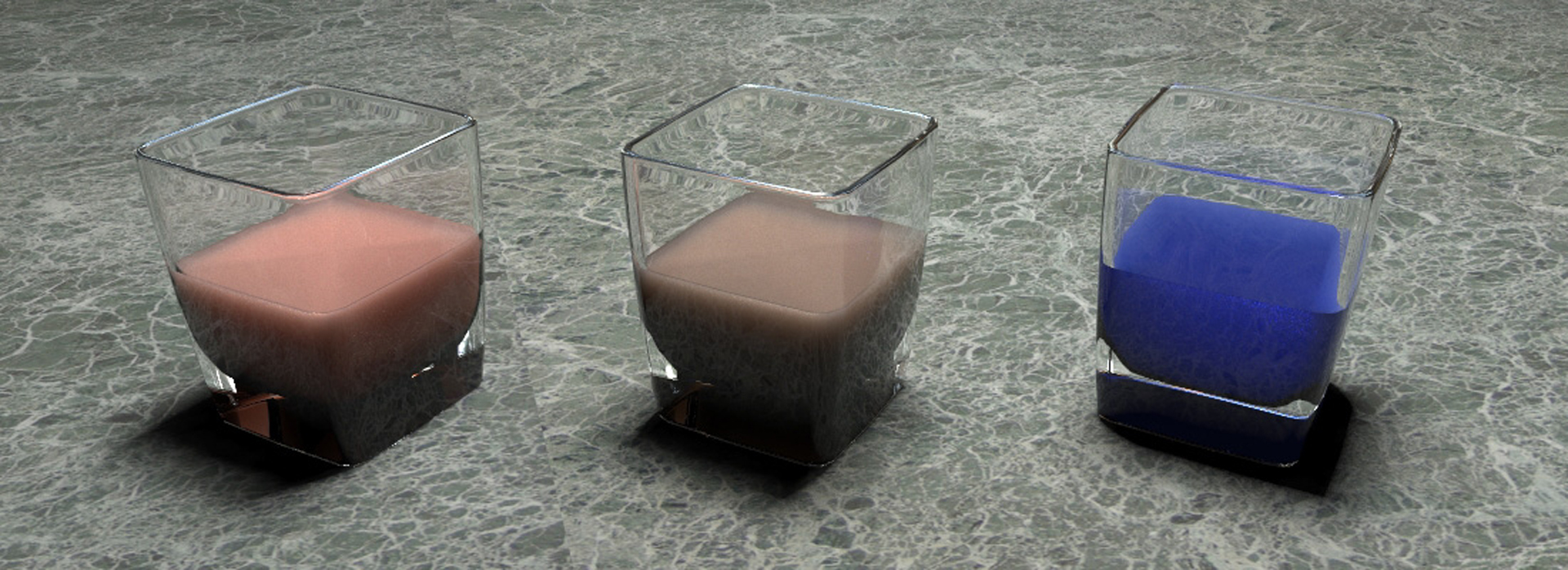“An empirical BSSRDF model” by Donner, Lawrence, Ramamoorthi, Hachisuka, Jensen, et al. …
Conference:
Type(s):
Title:
- An empirical BSSRDF model
Presenter(s)/Author(s):
Abstract:
We present a new model of the homogeneous BSSRDF based on large-scale simulations. Our model captures the appearance of materials that are not accurately represented using existing single scattering models or multiple isotropic scattering models (e.g. the diffusion approximation). We use an analytic function to model the 2D hemispherical distribution of exitant light at a point on the surface, and a table of parameter values of this function computed at uniformly sampled locations over the remaining dimensions of the BSSRDF domain. This analytic function is expressed in elliptic coordinates and has six parameters which vary smoothly with surface position, incident angle, and the underlying optical properties of the material (albedo, mean free path length, phase function and the relative index of refraction). Our model agrees well with measured data, and is compact, requiring only 250MB to represent the full spatial- and angular-distribution of light across a wide spectrum of materials. In practice, rendering a single material requires only about 100KB to represent the BSSRDF.
References:
1. Blinn, J. F. 1982. Light reflection functions for simulation of clouds and dusty surfaces. In Computer Graphics (Proceedings of SIGGRAPH 82), vol. 16, 21–29. Google ScholarDigital Library
2. Bouthors, A., Neyret, F., Max, N., Bruneton, E., and Crassin, C. 2008. Interactive multiple anisotropic scattering in clouds. In I3D ’08: Proceedings of the 2008 symposium on Interactive 3D graphics and games, 173–182. Google ScholarDigital Library
3. Cerezo, E., Perez-Cazorla, F., Pueyo, X., Seron, F., and Sillion, F. 2005. A survey on participating media rendering techniques. The Visual Computer.Google Scholar
4. Dana, K., Ginneken, B., Nayar, S., and Koenderink, J. 1999. Reflectance and texture of real-world surfaces. ACM Trans. Graphic. 18, 1, 1–34. Google ScholarDigital Library
5. Donner, C., and Jensen, H. W. 2005. Light diffusion in multi-layered translucent materials. ACM Trans. Graphic. 24, 3, 1032–1039. Google ScholarDigital Library
6. Donner, C., and Jensen, H. W. 2007. Rendering translucent materials using photon diffusion. In Rendering Techniques, 243–251. Google ScholarDigital Library
7. Goesele, M., Lensch, H. P. A., Lang, J., Fuchs, C., and Siedel, H.-P. 2004. DISCO: aquisition of translucent objects. ACM Trans. Graphic. 23, 3, 835–844. Google ScholarDigital Library
8. Hanrahan, P., and Krueger, W. 1993. Reflection from layered surfaces due to subsurface scattering. In Proceedings of SIGGRAPH 1993, 164–174. Google ScholarDigital Library
9. Jensen, H. W., and Buhler, J. 2002. A rapid hierarchical rendering technique for translucent materials. ACM Trans. Graphic. 21, 576–581. Google ScholarDigital Library
10. Jensen, H. W., Legakis, J., and Dorsey, J. 1999. Rendering of wet materials. In Rendering Techniques, 273–282. Google ScholarDigital Library
11. Jensen, H. W., Marschner, S. R., Levoy, M., and Hanrahan, P. 2001. A practical model for subsurface light transport. In Proceedings of SIGGRAPH 2001, 511–518. Google ScholarDigital Library
12. Jensen, H. W. 1996. Global illumination using photon maps. In Rendering Techniques, 21–30. Google ScholarDigital Library
13. Jensen, H. W. 2001. Realistic Image Synthesis Using Photon Mapping. AK Peters. Google ScholarDigital Library
14. Joshi, N., Donner, C., and Jensen, H. W. 2006. Noninvasive measurement of scattering anisotropy in turbid materials by nonnormal incident illumination. Opt. Lett. 31, 936–938.Google ScholarCross Ref
15. Kajiya, J. T. 1986. The rendering equation. In Computer Graphics (Proceedings of SIGGRAPH 86), 143–150. Google ScholarDigital Library
16. Korn, G. A., and Korn, T. M. 2000. Mathematical Handbook for Scientists and Engineers: Definitions, Theorems, and Formulas for Reference and Review. Courier Dover Publications.Google Scholar
17. Li, H., Pellacini, F., and Torrance, K. 2005. A hybrid monte carlo method for accurate and efficient subsurface scattering. In Rendering Techniques, 283–290. Google ScholarDigital Library
18. Matusik, W., Pfister, H., Brand, M., and McMillan, L. 2003. A data-driven reflectance model. ACM Trans. Graphic. 22, 3, 759–769. Google ScholarDigital Library
19. Narasimhan, S. G., Gupta, M., Donner, C., Ramamoorthi, R., Nayar, S., and Jensen, H. W. 2006. Acquiring scattering properties of participating media by dilution. ACM Trans. Graphic. 25, 1003–1012. Google ScholarDigital Library
20. Nicodemus, F. E., Richmond, J. C., Hsia, J. J., Ginsberg, I. W., and Limperis, T. 1977. Geometrical Considerations and Nomenclature for Reflectance. National Bureau of Standards.Google Scholar
21. Peers, P., Vom Berge, K., Matusik, W., Ramamoorthi, R., Lawrence, J., Rusinkiewicz, S., and Dutré, P. 2006. A compact factored representation of heterogeneous subsurface scattering. ACM Trans. Graphic. 25, 3, 746–753. Google ScholarDigital Library
22. Pharr, M., and Hanrahan, P. 2000. Monte carlo evaluation of non-linear scattering equations for subsurface reflection. In Proceedings of SIGGRAPH 2000, 75–84. Google ScholarDigital Library
23. Premože, S., Ashikhmin, M., and Shirley, P. 2003. Path integration for light transport in volumes. In Rendering Techniqes, 52–63. Google ScholarDigital Library
24. Premoze, S., Ashikhmin, M., Tessendorf, J., Ramamoorthi, R., and Nayar, S. 2004. Practical rendering of multiple scattering effects in participating media. In Rendering Techniques, 363–374. Google ScholarDigital Library
25. Stam, J. 1995. Multiple scattering as a diffusion process. In Rendering Techniques, 41–50.Google Scholar
26. Tong, X., Wang, J., Lin, S., Guo, B., and Shum, H.-Y. 2005. Modeling and rendering of quasi-homogeneous materials. ACM Trans. Graphic. 24, 3, 1054–1061. Google ScholarDigital Library
27. Ward, G. J. 1992. Measuring and modeling anisotropic reflection. In Computer Graphics (Proceedings of SIGGRAPH 92), 265–272. Google ScholarDigital Library
28. Westin, S. H., Arvo, J. R., and Torrance, K. E. 1992. Predicting reflectance functions from complex surfaces. In Computer Graphics (Proceedings of SIGGRAPH 92), 255–264. Google ScholarDigital Library
29. Zhang, Z. 1999. A flexible new technique for camera calibration. IEEE Transactions on Pattern Analysis and Machine Intelligence 22, 11, 1330–1334. Google ScholarDigital Library





